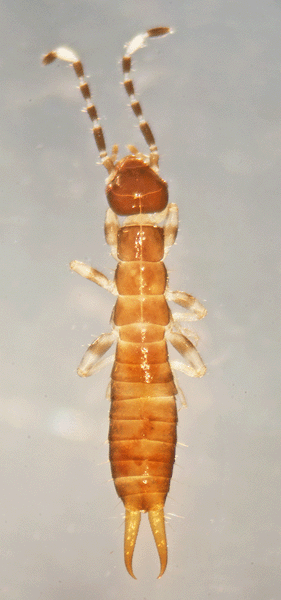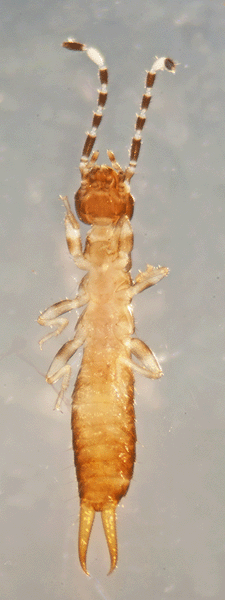Order Dermaptera (Earwigs) in the Christopher B. Smith Preserve
Order Dermaptera Characteristics: Earwigs have elongated and flattened bodies, thread-like antennae with at least 10 segments, biting mouthparts, and no ocelli. This insect order can be easily recognized by the cerci... a pair of forceps or pincers on the abdomen. Males have curved cerci, while female cerci are straight. Cerci are used to capture and hold prey, for defense, as an aid in copulation, and to fold the membranous hind wings under the short, leathery forewings.
The name "Dermaptera" means "skin wings." Most dermapterans have wings, but there are exceptions. Even those species with wings rarely fly.
Dermapterans are mostly nocturnal, hiding in moist crevices during the day, and actively feeding on a variety of insects and plants at night. Most are scavengers, some are omnivores, and others are predators. Some cause damage to plants.
A dermapteran's lifetime is ~1 year. Metamorphosis is incomplete with 4 to 6 molts. The mother lays her eggs and takes care of them by providing warmth and defending against predators. She even cleans them to remove fungi. She also protects the nymphs until their second molt, feeding them food she regurgitates.
Dermapterans are prey by birds, insectivorous mammals, amphibians, lizards, centipedes, assassin bugs, yellow jackets, tachinid flies, roundworms, spiders, and parasitic fungus. Earwigs are known to cannibalize their own eggs and nymphs.
There are 1,800 species in 12 families worldwide. Twenty-five of these species are found in North America.
Interactions in the Smith Preserve: Dermapterans are part of the food web, keeping populations of other arthropods in check, and providing food for other species.
Family |
Species Name |
Common Name |
Anisolabididae |
Euborellia annulipes |
Euborellia annulipes Ring-Legged Earwig
|
© Photographs and text by Susan Leach Snyder (Conservancy of Southwest Florida Volunteer), unless otherwise credited above.


 On November 17, this 5 mm long earwig was captured in a pit trap placed below a
On November 17, this 5 mm long earwig was captured in a pit trap placed below a